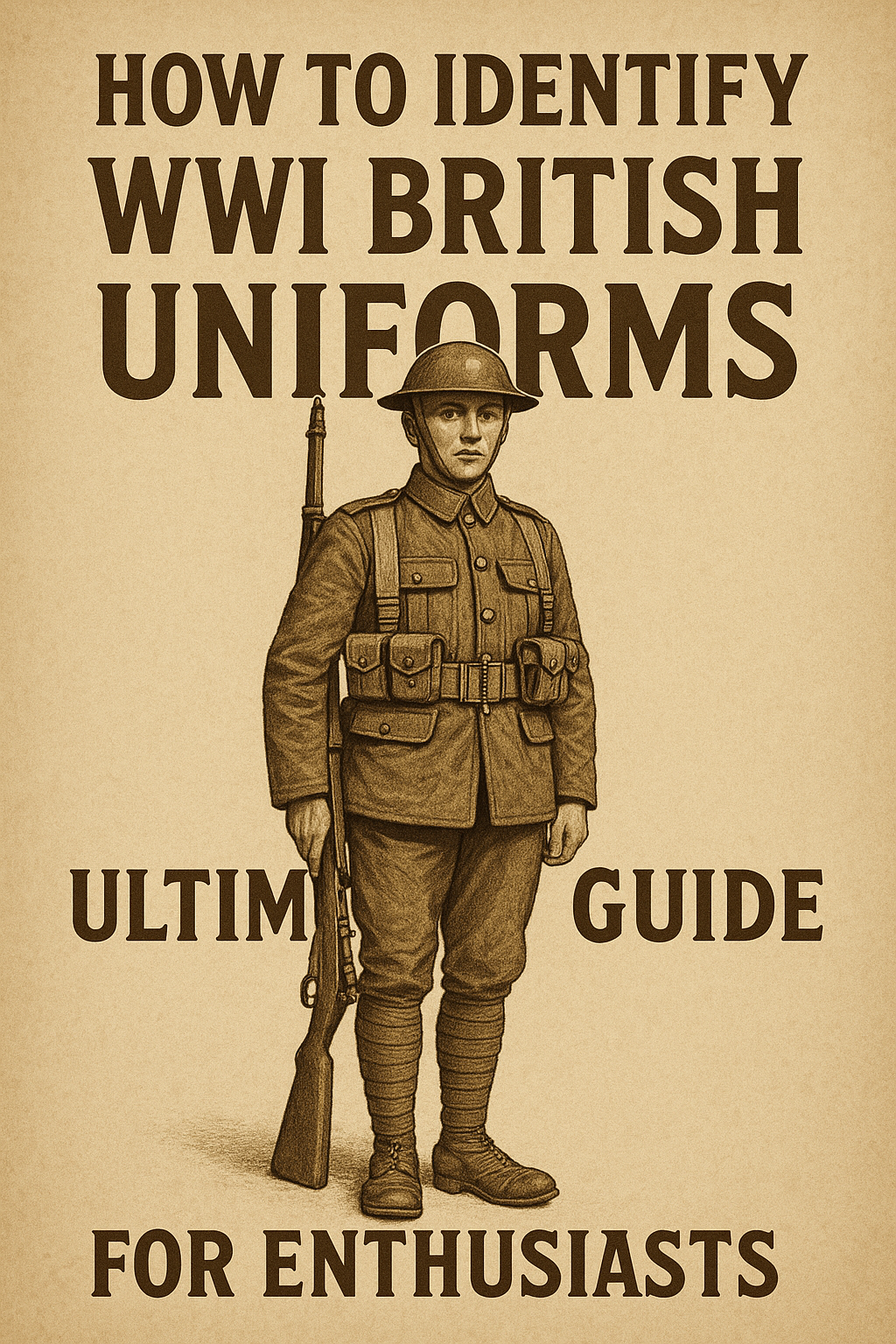
How to Identify WWI British Uniforms: Ultimate Guide for Enthusiasts
Published on Jul 03, 2025
1. Introduction to First World War British Uniforms
During the First World War era, British military uniforms evolved to meet the harsh realities of trench warfare. From the well-recognized “Service Dress” to specialized marine and officer outfits, these garments tell stories of rank, branch, and battlefield conditions.
✅ Why this matters for reenactors & collectors:
- Authenticity in events and displays
- Protecting historical accuracy
- Enhancing knowledge for sourcing and restoration
2. The WWI British Officer Uniform
2.1 Service Dress Tunic
- Khaki wool fabric replaced brighter Redcoat shades post-1902
- Standing collar, often starched and stiff
- Chest pockets with scalloped flaps and brass buttons
- Rank insignia (pips for lieutenants/captains, crowns/beetle for majors and above) on the shoulder straps
2.2 Trousers & Breeches
- Wool trousers in khaki, straight-cut
- Riding breeches with boots for mounted officers
2.3 Headgear & Accessories
- Service cap with a leather peak, regimental badge, piping
- Sam Browne belt, complete with cross-strap and holster
- Officer’s Sam Browne sword or swagger stick
- Puttees (hemmed in linen) wrapped around boots for protection and warmth
2.4 Recognizing Variants
- Regimental badges – each regiment had distinctive crests
- Warrant Officer vs Commissioned Officer – differences in epaulet insignia and sleeve lace
- Specialist roles: chaplains, medical officers, and staff wear unique badges
Use the keyword wwi British officer uniform throughout this section to improve visibility.
3. Identifying a WWI Marine Uniform
British marine uniforms during WWI reflected naval traditions combined with field practicality.
3.1 Tunic & Jacket
- Dark navy-blue wool tunic, double-breasted front
- Large square cuffs with lace denoting rank
- Shoulder boards with embroidered anchor or crown
3.2 Trousers & Footwear
- Matching navy trousers, straight cut
- Worn with ankle boots or Wellington boots
3.3 Headgear & Equipment
- The classic “Pork Pie” style cap with flap
- Webbing belts, pouches, and small arms typical of marine rifle platoons
- Not commonly worn with Sam Browne belts
3.4 Field Gear
- Waterproof capes, canvas haversacks, and mess tins
- Rank stripes on cuffs: chevrons for petty officers, crown badges for commissioned ranks
This section integrates the keyword ww1 marine uniform, supporting discovery for niche-center audiences.
4. Comparison: WWI vs WWII British Soldier Uniforms
Let’s explore how uniforms evolved between the two world wars.
4.1 Color & Fabric
- WWI khaki shade was muted and greenish; WWII uniforms trended darker with improved wool blends
- WWII battle dress (BD) had a shorter, more functional tunic with waist pleats
4.2 Practical Adjustments
- WWI puttees were replaced in WWII by webbing gaiters and camouflage smocks
- Steel Brodie helmets, introduced in WWI, became universal by WWII
4.3 Rank & Insignia Placement
- WWI stripes often on sleeves; WWII shifted these to shoulders or chest
- Lanyard colors, collar dogs, and cap badges gave quick clues to regiment or corps identity
Including the WW2 British soldier uniform strategically here helps capture searches comparing both eras.
5. Quick Tips for Authentic Identification
- Check buttons closely: Regimental crests were pressed into brass or plastic, and officers had gilded ones..
- Inspect linen lining: Early WWI tunics have white linen; later versions switched to khaki..
- Look at stitching and braces: Hand-sewn edges usually belong to the 1914–1916 period..
- Smell the wool: Vintage uniforms have a characteristic lanolin wax aroma—especially after proper storage..
- Use micro-detail guides: Obscure differences like collar-body overlap and tunic lining finish separate early-war from late-war issue..
6. Field Markings, Battle Damage & Dyes
- Artillery marks: faded oil stains or speckled grey/brown camouflage
- Battle scarring: rips, bloodstains, patched-up elbows
- Tailored modifications: extra radio pockets, reinforced knees, or stitched-up epaulets
These add visual authenticity and collectible character.
7. Photography & Archive Help
Historical photos labeled by date, unit, and badge are invaluable. To identify the period and rank, compare a tunic’s collar shape or pocket cut against known wartime photos.
8. Where to Source & Restore Uniforms
- Reenactor networks: Reliable supply from WWI collectors and specialist camps
- Auction sites: Check provenance and inspect high-resolution photos carefully
- Surplus vendors: Original items may be chemically treated—account for rare dyes and cleanup
Pair with WWII surplus to create period-accurate gear bundles.
9. SEO-Focused Article Structure
Your article already leverages keywords naturally:
- Wwi British officer uniform — included in heading and section 2
- WW2 British soldier uniform — used in comparative analysis
- ww1 marine uniform — highlighted in section 3
To further boost SEO:
- Use internal links to your pillar page (“First World War British uniform”) and subpages (“WWII British soldier uniform,” “WWI marine uniform”)
- Include alt text for images: e.g., “WWI British officer Sam Browne belt close‑up.”
- Use bullet lists, H2/H3 headers, and short paragraphs for readability
- Add a backlink section with recommended archival or military museum URLs
10. Conclusion
Mastering WWI British uniform identification means knowing small but telling details—collar linings, button stamps, puttee style, and insignia placement. This guide will help collectors, reenactors, and historians feel more confident in evaluating and sourcing genuine uniforms from the Great War.
